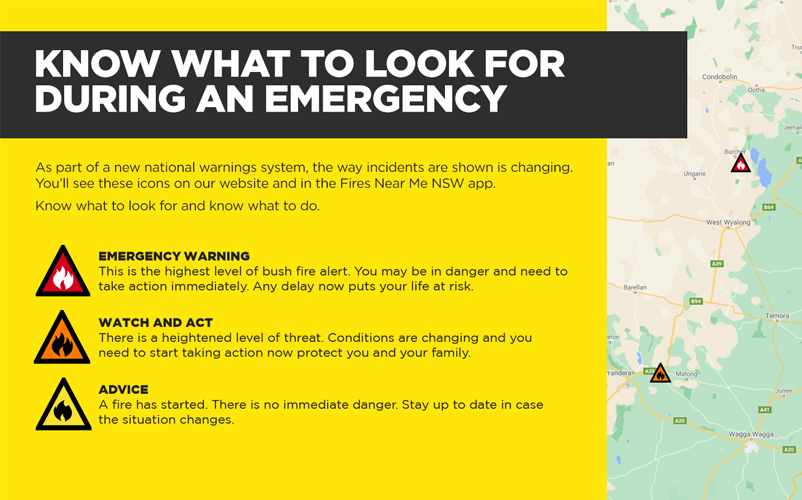The ‘Scaled Advice and Warning Framework for Bushfire’ was agreed nationally in 2009 following the Black Saturday bushfires in Victoria in February 2009. While it was developed with urgency and national commitment, it is acknowledged that there was limited opportunity for community involvement or feedback on the framework.
These warning arrangements for bushfire have worked well since the Australasian Fire and Emergency Service Authorities Council (AFAC) facilitated their development. They have been widely accepted over the past 10 years and understood by media and communities likely to be affected by bushfire.
Since 2009, considerable work to build a national capability to deliver timely and tailored warnings to communities has included developing the Public Information and Warnings Handbook and the National Warnings Principles as well as training and professional development for warnings practitioners. Fire and emergency services agencies have also invested in digital platforms to convey warnings to communities including websites and apps, and Australia’s Emergency Alert telephone alerting system continues to be improved.
The National Review of Warnings and Information conducted in 2014 allowed for investigation across a multi-hazard and national sphere of how warnings and information were provided to communities. The review considered both warnings about hazards, such as those provided by the Bureau of Meteorology, and warnings about the potential impact of an incident on a community, typically provided by fire and emergency services and other statutory authorities.
The review recommendations included establishing the dedicated, multi-hazard National Working Group for Public Information and Warnings. Subsequently, the Australian New Zealand Emergency Management Committee endorsed the creation of the National Public Information and Warnings Working Group as part of the AFAC Collaboration Network (Warnings Group). The Warnings Group has been progressing the concept of a multi-hazard, all state and territory warning system in line with the review’s Recommendation 3:
Pursue greater national consistency of warning frameworks across jurisdictions by leading a coordinated review of current frameworks, assessing the evidence base for change, and identifying opportunities for harmonisation. While this requires a longer term focus, in the short term, build national consistency within individual hazard areas.
In response to Recommendation 3, in October 2017, the Commissioner’s and Chief Officers’ Strategic Committee (CCOSC) committed to a consistent 3-level national warnings framework across all states and territories and multiple hazards. In February 2018, the Warnings Group established a project plan, ‘Towards a National Warning Framework’. Following consultation with the states and territories, the project plan was endorsed by CCOSC in May 2018.
CCOSC also endorsed the Multi-hazard Warning System Social Research Project1 in July 2018. This research was an extension of the Australian Fire Danger Rating System social research project. Research commenced in August 2018, with a fourth and final round of research taking place in July 2020.
The research was conducted to understand, from a community perspective, how people perceive and take action in response to warnings. This was the first time a national study of community perceptions of warnings at this scale had been undertaken. The research found broad community support for a 3-level warning system that is the same across multiple hazards. That is, people do not want different warning systems for different hazards. They want one system that is simple to understand and encourages them to take action.

From December 2020, new icons will be used to display bushfires on the NSW RFS website and Fires Near Me NSW smartphone app.
Using the research, and the experience of emergency services agencies, the Australian Warning System includes 3 warning levels: Advice, Watch and Act and Emergency Warning. These levels will be combined with the hazard type (e.g. bushfire, flood, severe storm, cyclone, extreme heat) and a call-to-action statement (e.g. prepare to leave, seek shelter) that gives the community clear direction about what to do during the emergency.
Using the outcomes of the community research, a consistent set of hazard icons has been developed that include:
- a triangle shape with sharp corners
- yellow, orange, red colour palette showing increasing risk
- icon size and type escalating in size as the warning level increases.
New hazard icons for bushfire were implemented in December 2020 for all states and territores except Western Australia and the Northern Territory, which will implement the hazard icons at a future date. For other hazards, these icons will be adopted progressively. Call-to-action statements have been finalised based on research conducted as part of the Bushfire and Natural Hazards Cooperative Research Centre program.


